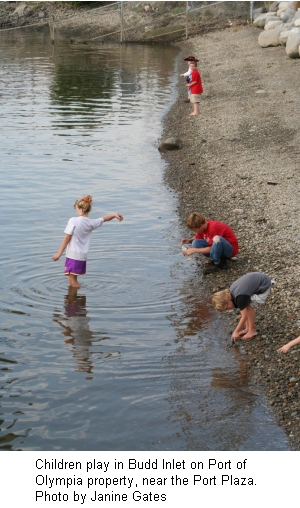The World According to PortBy Harry Branch
East Bay, the southeastern portion of the Port Peninsula, has the look of an area perfect for development. Some time ago, the Port hatched plans for a new City Hall, plazas, a hotel and a Hands On Children's Museum. Some of the land would also be sold to LOTT Alliance for sewage treatment expansions and educational displays that would tie into the Children's Museum. As ideas materialized, things fit together in a very appealing way. But not all things. Historic photos of the area show the kinds of industrial activities that leave a malevolent chemical legacy. Much of the land is also fill, possibly from contaminated dredge spoils. And the area was historically estuarine tide flats and is an ideal candidate for restoration. Midway along, the City withdrew interest in building a city hall at East Bay and purchased another site. Well into the planning process the Port hired a consultant to conduct soil assessments and develop a plan. Months passed and twice the results were delayed. When the numbers were finally made public, they weren't good. Four soil samples were assessed for dioxins. All exceeded commonly accepted levels by fivefold and up. One sample contained 645.7 parts per trillion (pptr) dioxins. The Model Toxics and Control Act dioxin standard for mixed use is 11 pptr. Not long ago the number was 7 pptr. Much effort has been made by vested interests with deep pockets to raise the level of acceptable risk. Much effort is continually invested by regulatory bodies in reviewing it. The conclusion of all this effort is that there is virtually no completely safe level of exposure. Dioxins have been repeatedly linked to cancer, nerve damage, endocrine disruption, birth defects and other problems. They have an almost unique ability to damage DNA. Dioxins are easily absorbed through the skin. They are particularly damaging to children. The Port claims that because dioxin is not soluble in water it will remain bound up in soil. This assumption would be more plausible if the area wasn't also contaminated with petrochemicals. Dioxins dissolve in oil (petrochemicals) and oil is propelled by groundwater. Groundwater rising and falling with the tide creates a hydraulic pumping action that causes a "smear zone"; the top layer of the water table, rich with lighter-than-water petrochemicals, is pushed up through overlying soils and drawn back down. This action leaches or extracts dioxins out of soil and into an ever-more-toxic, ever-spreading soup. The East Bay project fell under the Voluntary Cleanup Program (VCP). Ecology could issue an unbinding opinion under the VCP but the project was basically in the Port's hands. Things looked like smooth sailing. Bids were taken and demolition of two large historic warehouses began. Then last month, to almost everyone's surprise, the Department of Ecology transferred the project from the VCP to Model Toxics and Control Act (the word "voluntary" no longer appears among the acronyms). The site had swelled beyond what Ecology considered a "routine cleanup," partly because sources for much of the contamination could not be identified. Additional characterization will be required along with more details of the cleanup plan. Ecology suggested that alternatives also be generated. At this time it remains unknown whether a plan to develop the area prior to a complete removal of contamination is even feasible. The Port's consultant is generating another work plan that will be available for public comment and subject to further review. This plan should include sampling the surface of the shallowest water aquifer and analyzing it for the presence of dioxin something the Port has yet to do. Meanwhile, the Port is vigorously pursuing development plans. On March 5, it issued $14 million in bonds for among other things East Bay development. All the pieces are present tidal impact on groundwater, petrochemicals and dioxin for a perfect storm. Even this would not be insurmountable. We simply need to determine the nature and extent of the problem and develop a real solution. At East Bay we might employ some combination of pumping and treating groundwater and soil remediation using fungi, bacteria and emerging technologies. Not all cleanup options blend well with pavement and buildings. The Port's development plans may not be consistent with a real cleanup plan. Does it make sense to invest so much effort into development prior to resolving the question of contamination? Harry Branch is a retired captain of fishing, charter and research vessels. He has a Masters of Environmental Studies degree from The Evergreen State College.
----
Author's Note: This story evolves almost daily. The Port of Olympia recently asked for a Construction Stormwater General Permit for "2.5 acres of soil disturbance for street, sidewalk, curb and gutter, underground utilities, landscaping, and street lighting construction activities," which collectively are touted as an impervious cap. Comments may be submitted to: Department of Ecology Stormwater, P.O. Box 47696, Olympia, WA 98504-7696
Back to Home page. |

